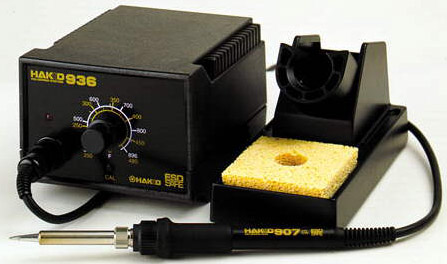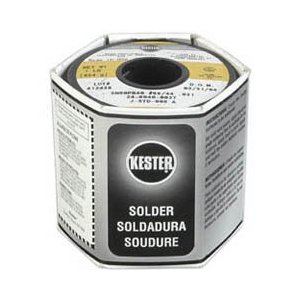
I have been asked by a LOT of folks which soldering iron I recommend. To give a little background, I used repair CRT monitors for a living back when A) a monitor was cheaper to repair than replace B) crt monitors were still in style. Sure it’s been a while but over the years I’ve used different irons. At that particular job, I used a Weller solder station. It wasn’t terrible but I can’t say it was overly impressive either. It was cheap ($60) and it got the job done. After that job, I didn’t buy my own solder station for years. Instead I bought cheapo irons from Radio Shack like it was going out of style. They used to be about $3 when I started buying them and now they are up to about $9. These irons sort of got the job done over the years but they had problems. I’ll just list off some of the top disadvantages that come to mind:
- They take forever to warm up to the proper temperature.
- They are unregulated so the temperature can be wildly inconsistent.
- The metals in the iron and tip are cheap and dissimilar. After a while the tip will loosen and it will be impossible to properly tighten it.
- The plating on the tip seems to be prone to gumming up and eventually becomes impossible to clean.
- If you drop the iron on the cord, it will burn through the insulation.
- They don’t come with a stand and I consider the ones they sell unsafe.
The main advantage, price, won me over all those years but I’ve rounded up my “collection” of these irons and it amounted to a large pile. I buy them like screwdrivers and strategically lose them in places where I’d likely remember to look later…
More recently, I’ve finally started soldering surface mount components on a regular basis so I decided I needed something that was regulated at the very least. Enter the Hakko 936. The 936 is NOT expensive for a solder station. In fact, you can get it on Amazon for around $85-$95 typically. Compared to my old Weller, it feels like a Mercedes Benz of soldering stations if there ever were such a thing. Instead of my typical conversational review, I will just explicitly list the advantages here:
- Heats up in 10-15 seconds.
- Indicator light lets you know it’s on.
- Temperature is regulated and it bounces back fast when pressed.
- Comes with a beefy stand with an integrated sponge to keep the tip clean.
- Burn proof wire from the iron to the base unit.
- ESD safe. (seems to be, I haven’t fried anything with it)
- Light weight iron feels well balanced in your hand.
- Tip stays clean for a long time.
- Chisel tip included with the iron is very versatile.(for my uses at least)
- Don’t need a 15w, 25w and a 40w solder iron to do different jobs. This one does it all.
There are probably even more advantages that I’m not thinking of but this list is a good start. Back when I started buying the crappy Radio Shack irons, I didn’t really know any better and soldering stations were still $150-$200 for a professional grade model. Thanks to global economics, demand and competition though, there are several choices under $150. Yes, there is also the Aoyue 936 for $50. I have not used it or compared them side-by-side but I can tell you that the Hakko looks, feels and performs like a professional piece of equipment. It does what I expect, when I expect it and overall has exceeded my expectations.
By the way, the Hakko(at least mine) is made in Japan if you were wondering. In the past, when I’ve tried to cut corners by purchasing the knockoff tool, I’ve ended up with something that doesn’t last and is disappointing. Anyone who has ever shopped at Harbor Freight knows what I mean. I expect the 936 will be the last soldering station I will ever need. Now a hot air pencil is a different story 😉 Beyond the 936 models, there is also the digital readout version of the Hakko solder station but it’s considerably more expensive for something that won’t make your soldering a damned bit better.
I keep my soldering station pegged at 700 degrees. If you are soldering something more sensitive or more heavy duty, adjust as needed obviously but 700 degrees seems to work well for my purposes. If you have concerns about this, consult the data sheet of the component you are trying to solder. Also, Don’t buy this awesome solder station and use crap solder. Grab a spool of Kester 44 Rosin Core Solder 60/40. I have a roll that I’ve been using since 2001(it’s dated) and it works great. The lead free solder is complete and utter garbage in my experience. It makes for lousy solder joints and is just generally hard to work with.
While you are rounding out your kit, a Flux pen and Chem-Wik desolding wick
are both extremely nice to have. Don’t buy 50′ of Chem-Wik from Amazon though. They come in 5′ rolls that should be less than $5 or so. Please feel free to comment on any experiences you’ve had with Hakko or Aoyue gear in the comments. Happy soldering!


